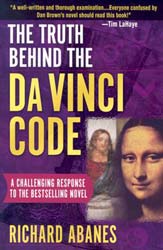|
The Truth Behind the Da Vinci Code by Richard Abanes Reviewed by Tim Chaffey |
|
I found this book on a discount shelf earlier this year. I had read and enjoyed two of Abanes' earlier books (Harry Potter and the Bible and Fantasy and Your Family). I finally started reading it yesterday and could not put it down. Since it is a relatively short book, I finished it quickly and realized that I wished it was a lot longer. In this book, Abanes critiques the extremely popular fictional novel by Dan Brown entitled The Da Vinci Code. One of the reasons this book is so controversial is because its author has attacked the authenticity and character of Christianity, the Bible, and Jesus Christ. Loosely basing his work on some of the Gnostic "gospels" and some forged documents created by the late Pierre Plantard, Brown claims that Jesus Christ was married to Mary Magdalene. The upshot of the novel is that Mary Magdalene was herself the legendary "Holy Grail" instead of the cup that Jesus drank from at the Last Supper. Apparently, Brown's goal is to convince the world that goddess worship is the true religion and that Christianity has done everything in its power to destroy this "truth." Brown also ties the famous artist, Leonardo da Vinci into the mix by twisting and distorting some of his artwork and notes. (A full review of The Da Vinci Code is coming soon). While the book is clearly fictional, there is a major problem in that Brown repeatedly states that all of his claims are well-substantiated by historians. Richard Abanes has done the world a huge favor for anyone interested in the truth about Brown's claims. In five chapters, he completely dismantles the alleged historicity of Dan Brown's novel. Abanes demonstrates that Brown is utterly wrong concerning at least fifty claims made in his book. These range from relatively minor details (such as Brown's claim that the pyramid outside the Louvre in Paris was made from exactly 666 pieces of glass - the Louvre's website states that it is made of nearly 800 pieces) to numerous major details. Brown severely distorts Church history concerning the New Testament canonization process, Constantine's role in the Church, and Jesus' divinity. Brown actually claims that Jesus was never considered to be the Son of God until the Bishops voted Jesus as divine at the Council of Nicaea by a narrow margin. The fact of the matter is that Jesus' own disciples recognized Him as the Son of God (see John 1: 1 and Matthew 16: 16 - 18) and so did the early Church. Also, during the Council of Nicaea, Arius' claim about the non-eternality of Jesus were soundly rejected by a vote of 316 to 2. That hardly qualifies as a narrow vote. Numerous examples could be given to show how badly Brown has distorted the truth. Abanes does a fantastic job of answering the fallacious claims presented as fact in The Da Vinci Code. Abanes divided his book into the following five chapters to deal with the many false accusations made by Brown: - Conspiracy Theories, Mass Confusion, and Rewriting History - Gnosticism, Ancient Gospels, and the Bible - Mary Magdalene, the Church, and Goddess Worship - The Grail, the Priory of Sion, and the Knights Templar - Leonardo, the Mona Lisa, and The Last Supper This book should be read by everyone who has read Brown's novel or plans to see the upcoming movie based on it. In an age where so many people are searching for the truth and seemingly willing to accept anything but the truth, it is tremendously important for Christians to be informed on this issue. The upcoming movie (starring Tom Hanks) will only add to the confusion. I strongly urge you to get a hold of this book (click on the picture above to order) and learn the facts of the matter. Undoubtedly, you have read or know someone who has read this book or will go to the movie. Be prepared! It would have received a 10 out of 10 if it would have been a little longer. See Cracking Da Vinci's Code for a review of a longer book on this subject. (10/15/05) |
|
Rating: (9.5 out of 10) About the Author
|
